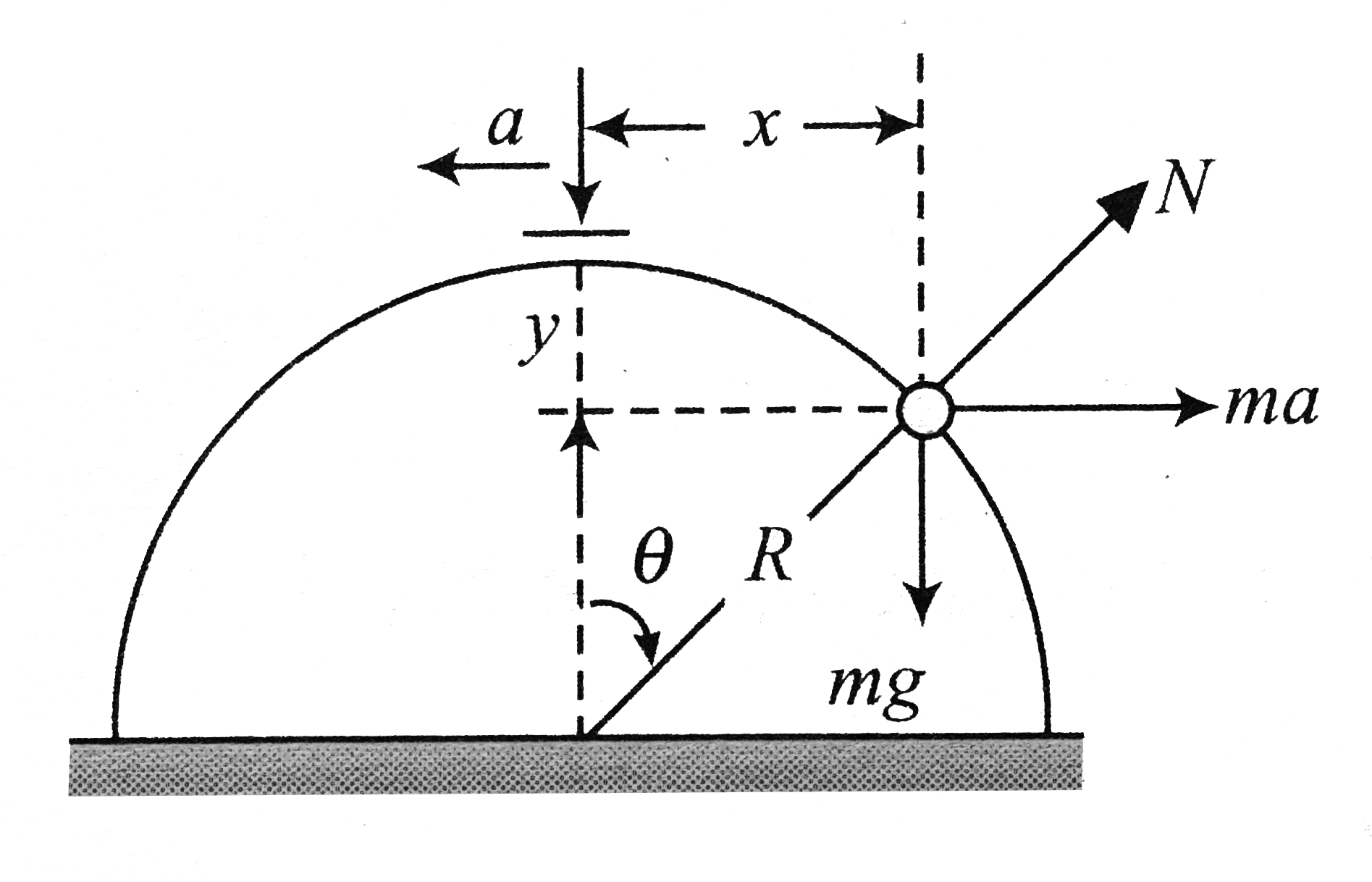A small ball is placed at the top of a smooth hemispherical wedge of radius R. If the wedge is accelerated with an acceleration a, find the velocity of the ball relative to wedge as a function of θ.

√2R[g(1−sinθ)+aRcosθ]
√2R[g(1+cosθ)−aRsinθ]
√2R[g(1−cosθ)+aRsinθ]
√2R[g(1+sinθ)−aRcosθ]
The correct Answer is:C
Here we analyze the motion of ball with respect to wedge. As we are analyzing the motion of the ball from accelerating wedge, we impose a pseudo force ma→on the ball.
The work done by the pseudo force is

Wps=max
The work done by gravity is Wgr=mgy
The work done by normal reaction force is zero as there is no relative sliding between the ball and the wedge in the direction of normal reaction.
Then, the total work done is
W=max+mgy (i)
KE: The change in kinetic energy of the ball relative to wedge is
K=12mv2 (ii)
where v is the velocity of the ball relative to wedge.
W-E theorem relative to wedge:
W=ΔK (iii)
From Eqs (i), (ii), and (iii), we have
max+mgy=12mv2
Substituting x=Rsinθ and y=R(1−cosθ), we have
v=√2{gR(1−cosθ)+aRsinθ}
Topper's Solved these Questions
- WORK, POWER & ENERGYBook:CENGAGE PHYSICSChapter:WORK, POWER & ENERGYExercise:Solved Examples
Explore 15 Videos
- WORK, POWER & ENERGYBook:CENGAGE PHYSICSChapter:WORK, POWER & ENERGYExercise:Exercise 8.1
Explore 25 Videos
- VECTORSBook:CENGAGE PHYSICSChapter:VECTORSExercise:Exercise Multiple Correct
Explore 5 Videos
Similar Questions
A small body is placed at rest at the bottom B of a smooth hemispherical surface of wedge as shown. If the wedge is shifted horizontally towards right with acceleration a0=3g, find speed of the body w.r.t the wedge at the instant the body reaches points A.
View SolutionFigure shows a block A constrained to slide along the inclined plane of the wedge B shown. Block A is attached with a string which passes through three ideal pulleys and connected to the wedge B. If wedge is pulled toward right with an acceleration a, find
(a) the acceleration of the block with respect to wedge
(b) the acceleration of the block with respect to ground.

View Solution
Knowledge Check
A wedge with a rough groove in the shape of a quarter of a circle is kept on a smooth table (see figure). A small block is placed in the groove with a small clearance. The wedge is moved with an acceleration√3g . If the block is to remain stationary relative to groove in the position shown, the coefficient of friction required can be:
 A13B14C15D910
A13B14C15D910In the arrangement shown in figure wedge of mass M moves towards left with an acceleration a. All surfaces are smooth. The acceleration of mass m relative to wedge is
 Aa/2B2MamC2(M+m)amD(M+m)am
Aa/2B2MamC2(M+m)amD(M+m)amA block of mass m is placed on a smooth inclined wedge ABC of inclination theta as shown in the figure. The wedge is given an acceleration a towards the right. The relation between a and theta for the block to remain stationary on the wedge is.
 Aa=gtanθBa=gcosecθCa=cosθDa=gsinθ
Aa=gtanθBa=gcosecθCa=cosθDa=gsinθ
A bead of mass m kept at the top of a smooth hemispherical wedge of mass M and radius R, is gently pushed towards right. As a result, the wedge slides due left Find the
a. speed of the wedge
b. magnitude of velocity of the beard relative to the wedge.

View SolutionA wedge of mass M rests with one face in contact with horizontal , smooth surface . A particle of mass m is placed on the smooth face on it , inclined at an angle αto the horizontal and released . Find the velocity of the wedge and that of the particle relative to the wedge when the particle has slipped a distance x down the face of the wedge . Also calculate the acceleration of the wedge and that of the particle relative to the wedge and the smooth surface .
[Hint : Apply principal of conservation of momentum along the horizontal and energy conservation principle . See Example 8 )
View SolutionAll the surfaces are smooth as shown in figure. The acceleration of mass m relative to wedge is :

View SolutionAll surfaces are smooth The acceleration of mass m relative to the wedge is
 .
.
View SolutionA small block of mass m is placed at rest on the top of a smooth wedge of mass M, which in turn is placed at rest on a smooth horizontal surface as shown in figure. It h be the height of wedge and θ is the inclination, then the distance moved by the wedge as the block reaches the foot of the wedge is

View Solution

